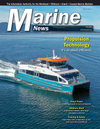
Page 28: of Marine News Magazine (July 2020)
Propulsion Technology
Read this page in Pdf, Flash or Html5 edition of July 2020 Marine News Magazine
OFFSHORE WIND
Offshore
Wind’s
Lift Off
By Eric Haun ffshore wind currently represents just a small has been growing at a much faster rate since 2010: 26% piece of the world’s energy supply. But that’s compound annual growth rate (CAGR) compared to 14% changing faster than ever before as new and for onshore. Even amid the current coronavirus pandemic, existing players look to tap the huge resource WER expects this trend to continue, with 16 GW of ad-
O potential—and market opportunities—being unlocked by ditional offshore capacity to be added in 2020 and 2021, shrinking costs and technological advances, as outlined in a driven primarily by ongoing activity in the well-established recent market report. Northern European sector as well as the newer, fast-growing
In the coming decades, the rapidly maturing offshore wind Chinese market. China, already the leader onshore, emerged market is expected to become a trillion-dollar business as the as a major offshore wind player in 2018 and has continued pace of installed capacity growth accelerates, according to to expand its substantial project pipeline.
World Energy Reports’ (WER) Outlook for Offshore Wind When comparing onshore wind vs. offshore in terms of un-
Power: The Frontier of Future Energy, published in June. A tapped potential, it’s clear that offshore is simply unmatched. webinar presented the report’s key ?ndings on June 17. The WER report estimates global offshore wind potential to be technically capable of supporting more than 120,000 GW
GROWING, WITH HUGE POTENTIAL of electricity production capacity (equating to approximately
Globally, the total installed energy capacity for both on- 420,000 TWh), which is more than 20 times greater than cur- shore and offshore wind farms at the end of 2019 totaled rent world demand.
651 gigawatts (GW), or about 10% of global electricity gen- By 2040, WER forecasts offshore wind capacity will in- erating capacity, according to the WER report. While just crease to somewhere in the range of 340 GW-560 GW, led 25.5 GW, or less than 0.5%, of that installed capacity is by Europe and China, with newer entrants the U.S., Japan, currently located at sea, the rate of new installations offshore South Korean and India among top markets. The report iden-
July 2020 28 MN

 27
27

 29
29
